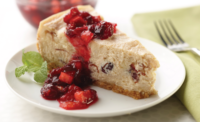Today’s foodservice market across the U.S. continues to reflect ongoing consumer desires for interesting and adventuresome flavors, items inspired by global cuisine, and better-for-you options—often where logically applicable, such as in items like hearty breads, muffins, and other baked goods that consumers accept as aligned with inherently nutritious dietary choices. Also, as we have seen in the retail market, more restaurants are now facing increased demand for products that align with specialty diets, like keto.
Flexibility remains a key asset in any foodservice operation, so bakers are also working to imbue the items they offer to foodservice operators with a longer shelf life without a loss in quality, making astute use of the increasing roster of functional ingredients available today.
Breakfast opportunities
“According to NPD Group, morning meals—including both breakfast and morning snacks—have shown consistent growth in recent years, and is the only foodservice daypart with year-over-year growth,” says Pam Stauffer, global marketing programs manager, Cargill, Minneapolis (“Breakfast is sunny side up,” NPD Group, March 8, 2019). “Convenient and affordable, it’s no wonder consumers are turning to foodservice for breakfast, and more restaurants are getting into the breakfast space.”
Growth of the breakfast daypart is driven by several factors,” says Mark Stavro, senior director of marketing, Bunge Loders Croklaan, Chesterfield, MO. “Foodservice breakfast offers today’s consumers a convenient option during one of the busiest times of the day. Breakfast also tends to be cheaper than other foodservice meals.”
According to recent analysis from Datassential, Chicago, healthy, flavor-packed options like multigrain and rye breads are the fastest-growing options as carriers for breakfast sandwiches, notes Mike Kostyo, trendologist.

“Consumers have long loved the breakfast sandwich because it’s inexpensive, is convenient and portable, and also constitutes a ‘balanced meal,’” says Starvo. “New takes on this classic are hot right now, from swapping out sausage and bacon for chicken, to replacing the biscuit with a tortilla for breakfast tacos.”
While nutritional rubrics factor into several types of baked goods central to the morning daypart, not everything needs to go “better-for-you.” Some morning staples, like doughnuts, will continue down their traditionally indulgent path and still strongly resonate with diners. Case in point, beignets, French-style doughnuts that are often made with higher-protein bread flour, are jumping onto breakfast menus, says Kostyo.
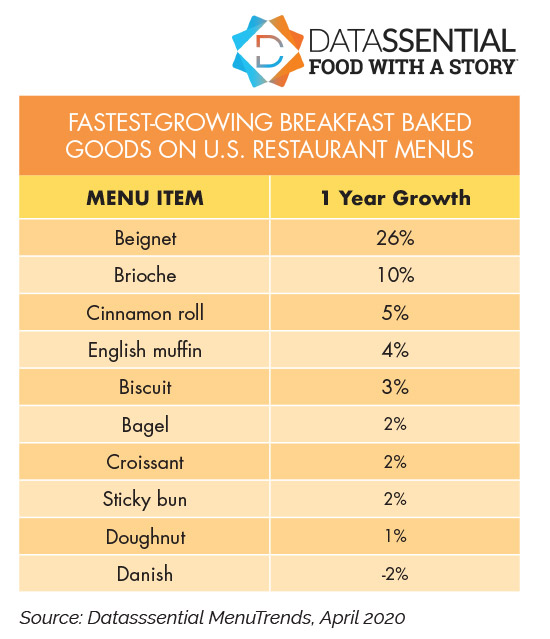
“For the past two to three years, doughnuts have been hot, a trend that shows no sign of waning,” says Jamie Mavec, marketing manager, global edible oil solutions, Cargill. “Doughnuts fit well in consumers’ on-the-go lifestyles, offering an easily portable, small indulgence as a reward during their busy days. Bakeries also have done their part to drive sales, with creative offerings that make their shops sought-out destinations for consumers. While the traditional yeast-raised or cake doughnut is still a crowd pleaser, innovations with exotic flavors, unique toppings, and daring mashups have transformed doughnuts into more than a breakfast treat.”
For some operators, the breakfast daypart has expanded to all day, with more breakfast menus available from sunup to sundown,” says Bill Hanes, VP marketing and strategy, Lesaffre, Milwaukee, WI. “This means that traditional breakfast fare, including biscuits, doughnuts, and muffins, need to stay fresh longer. Our portfolio of clean label ESL technologies can ensure diners enjoying breakfast in the morning or afternoon will have the eating experience they expect. In fact, our Encore Soft product has proven to keep doughnuts fresh and soft for two times longer. Recent case studies examined doughnuts over 24- and 30-hour periods. The surface of doughnuts made with Encore Soft were approximately 21 percent softer than the doughnuts without it.”
Stauffer sees strong opportunities for breakfast baked goods. “Muffins offer a unique opportunity, as they lend themselves to more-healthful formulations. The most-common ask we’re hearing is for help with increasing protein content or formulating for special diets—particularly keto, but there are also customers pushing to reduce sugars or add fiber.”
There’s a buzz around vegan and savory muffins lately, says Darren Belnavis, global corporate chef and director of culinary, The Hershey Co., Derry Township, PA. “Some of the flavors being recognized are sun-dried tomato and jalapeño cheese, which were previously only thought of when referring to corn muffins.”
Bakers are increasingly fortifying muffins and other baked goods with ingredients like pea protein to produce solutions for gluten-free and vegan muffins with added protein, says Belnavis. “This trend is also aiding in a variety of selections for special diets like keto, reduced sugar, and formulations with added fiber. In the last 12–18 months, requests for keto-friendly and protein-rich formulations have outpaced requests for gluten-free products.”
Bread and sandwiches
“The still-strong resurgence of artisan breads and rolls is still a large contributor to the demand for artisan craft sandwiches,” says Belnavis. “Ciabatta, brioche, and focaccia breads lend themselves to new and exciting sandwich creations.”
According to recent analysis from Datassential, health-driven and global breads are driving growth, notes Kostyo. “Premium options, like brioche, have been overtaken by healthy options like bread made with chia seeds, which saw a big jump in growth last year. Global options like steamed buns and bao, lavash, and garlic naan are also big growth drivers.”

The demand for functional baked goods is growing. “With bread being a sandwich staple, there is opportunity for foodservice operators to increase appeal by fortifying their sandwich breads with desirable ingredients,” says Hanes. “With our Accent technology, bakers can fortify baked goods with calcium with little to no impact on the eating experience.” Those capabilities can deliver the same level of calcium as a glass of milk in a 6-inch sandwich roll.
Research is also indicating that fortified, clean-label, and organic bread are preferred choices across the world, says Hanes. “Lesaffre offers an extensive portfolio of clean-label ESL and dough conditioning ingredients, and Red Star offers the only commercially available organic yeast produced in the U.S.”
“For those bakers looking to provide reduced-sugar options for their customers, Cargill supplies Oliggo-Fiber chicory root fiber, Zerose erythritol, and a wide variety of stevia leaf extracts and steviol glycosides, all of which can help to achieve meaningful reductions in sugar while maintaining appropriate sweetness levels and desired textural characteristics,” says Christensen.
“Plant-based protein has been a big focus for the internal part of the sandwich, and it stands to reason we’ll see more focus on incorporating plant-based proteins into the sandwich carrier, as well,” says Tim Christensen, Certified Master Baker, R&D bakery applications, Cargill. “Soy flour, pea protein, wheat gluten, and other plant proteins can all add a protein boost and reinforce the plant protein story showcased in the sandwich filling.”
Gluten-free options remain on-trend, which offers opportunities for ingredients like corn flour, says Christensen. “There also continues to be a focus on ethnic flavors, and adding specific seeds, herbs, flavors, or colors to the sandwich carrier can promote more interest and enhance authenticity.”
Offering products with enhanced nutritional benefits like plant protein is a great way to attract consumers, says Christensen. “There are several plant-based options that bakers can incorporate into buns, rolls, and tortillas.” He suggests Cargill’s line of Prolia soy flours and the company’s portfolio of PURIS pea proteins as options to boost protein levels in baked goods.
This approach can help operators boost total protein delivered in a vegetarian or vegan sandwich featuring a plant-based protein solution, like the Impossible Burger—or something more ethnic, like a falafel sandwich.
Ethnic inspirations continue to appear on sandwich menus. “The bánh mì has reclaimed its spot as the fastest-growing sandwich in America,” says Kostyo. “Again, global flavors are driving growth, from Asia (bánh mì), Latin America (torta), and France (croque madame). Don’t ignore regional American favorites, like lobster rolls, po boys, fried chicken sandwiches, tartines, and Philly cheesesteaks.”
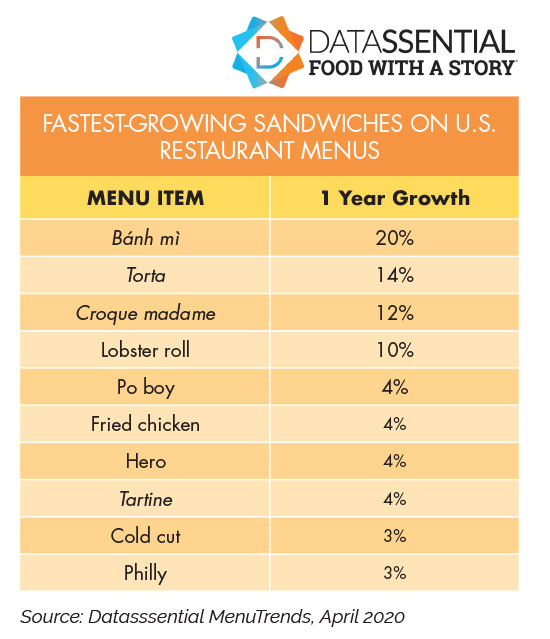
The recent coronavirus pandemic has impacted some aspects of bakery product distribution to restaurants, in some cases with more-infrequent deliveries. This might necessitate analysis of how bakery products are stored before use. “The challenge with distribution and determining how to buy is ensuring there’s enough inventory until the next delivery,” says Bart Elling, manager, sales development, food service, Ingredion Incorporated, Westchester, IL. “With daily deliveries, questions such as whether bread needs to be frozen and defrosted were not an issue, but now need to be considered.” These shifts in distribution preferences might carry over after the pandemic recedes, potentially making frozen product distribution more attractive to foodservice operators.
Dessert inspirations
“Dessert trends focus on flavor,” says Starvo. Bakers are experimenting with savory, global, and nostalgic flavors, and diners are eating it up, he says.
“Well-known classic flavors still dominate the menu, but trending flavors are being incorporated at different levels,” says Belnavis. “For example, salted honey, banoffee, cardamom, matcha green tea, and ginger are appearing as new flavors in the dessert category at the trendiest establishments. More-mainstream operations are adapting to flavors of hazelnut, sea salt, and marshmallow (think s’mores).”
Over the past year, milk chocolate saw surprising growth in cakes, says Kostyo. “Dark chocolate has been the fastest-growing chocolate option overall on menus, but classic favorite milk chocolate is growing in cakes. Cinnamon, in options like tres leches cake and Mexican chocolate cakes, is also growing.”

Doughnuts aren’t just for breakfast anymore. Mavec suggests developing more doughnut varieties specifically for the dessert menu. “Many of the key trends driving the sweet goods segment encourage creativity, from innovative mashups to unique flavor combos, and doughnuts seem to be a great outlet for these trends. They can satisfy the need for comfort food or be an exciting, decadent treat. Upscale restaurants have doughnuts on the dessert menu.” She cites trends like offering decadent fillings, including passionfruit or lemon curd, as well as employing cake riffs for doughnuts, like red velvet cake or pineapple upside-down cake.
A wide range of ingredients can help bakers improve doughnut quality while streamlining production. “PalmAgility products help reduce shortening brittleness across a wider temperature range, allowing customers to store them easily without sacrificing workability or texture,” says Mavec. “This also helps address issues that can develop in transportation due to fluctuations in outdoor temperatures, a variable outside of customer control. In addition, PalmAgility provides a smoother, creamier texture than standard palm oil shortenings. This aids in faster mixing time and better incorporation of all ingredients, both of which are easier on baking equipment. A faster crystallization rate also helps improve setting in glazes for doughnuts, for example.”
Mavec notes that the PalmAgility product line includes:
- PalmAgility 204 and 305 All-Purpose Shortenings—all-around high-performing shortenings that work well in a variety of bakery applications, including pies and cakes
- PalmAgility 213 and 217 Donut Fry Shortenings—faster set-up on the doughnut surface and reduced oil weeping over 24 hours compared to standard palm-based doughnut fry shortenings, improving visual appeal
- PalmAgility 210 Danish Shortening—superior sheeting performance for a pliable dough, helping reduce breakage during sheeting even when the dough is stored at temperatures below 65˚F
“Mashups of two dessert applications, such as the infamous cronut or Taco Bell’s churro doughnut, continue to attract attention,” says Gretchen Hadden, marketing communications manager, Cargill Cocoa & Chocolate North America. “Conversely, there are groups of consumers out there who still want to treat themselves, but are more label-conscious, or perhaps are seeking options that fit with their diet, be it due to lifestyle choices, allergies, or intolerances.” She notes that bakers formulating desserts for restaurants are responding to meet these unique consumer needs with vegan and gluten-free options.
“When it comes to desserts, consumers remain drawn to decadence, with less concern about calorie counts or fat content,” says Christensen. “Still, there are a few indications we could be on the cusp of a more health-conscious era. The move toward smaller, more-convenient sizes is a first step, delivering finished products that are slightly lower in overall calories.” He also notes a slow but continued move toward sugar reduction in desserts like cakes. “We’ve even seen interest in reducing fats and added sugars in cheesecakes.”
Christensen notes that Cargill is also seeing more interest in keto-friendly products and low-carb foods, including desserts. “To create keto-friendly baked goods, formulators often aim to eliminate added sugar, increase fiber and protein, and add more fat. Low-carb ingredients like soy flour and pea protein can help with these formulations. They hold onto water, resulting in a better mouthfeel, which is often a challenge in keto bakery products. Other keto-friendly ingredients include stevia, erythritol, and chicory root fiber.”
Starvo notes that the ingredients in the Vream Elite line of shortenings from Bunge Loders Croklaan are tailored to specific applications, so bakers developing items for foodservice can realize improved functionality and sensory results for products like cakes and pies. “Vream Elite is made by using enzymes to blend high-stability soybean oil and soy hard fat.” It lets bakers create high-volume cakes and flaky pie crusts, among other applications. “Vream Elite is also very easy to use, as it has great workability across a wide range of temperatures, shows exceptional creaming with all types of ingredients, and avoids post-hardening,” he says.
When it comes time for dessert, nostalgia sells. “Nostalgic pies are growing quickly,” says Kostyo. “Chocolate mousse pie, both a nostalgic and premium option, saw big growth last year. Cream pies also saw a lot of growth.”
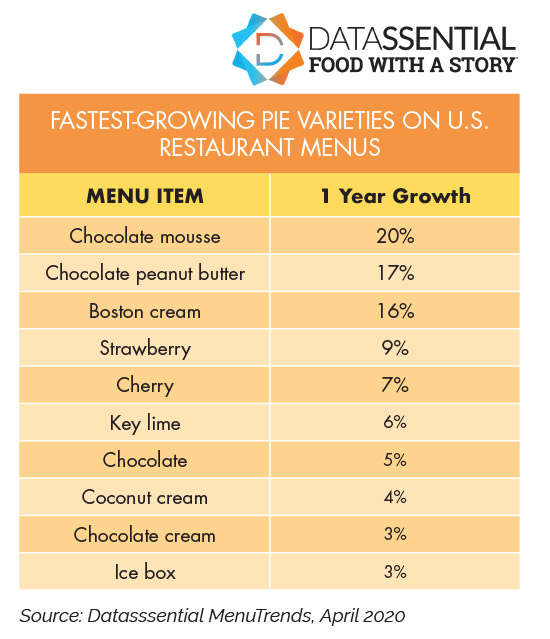
“Tropical mango saw huge growth in cheesecakes last year,” says Kostyo. “Also pay attention to unique options like Basque ‘burnt’ cheesecake and fluffy Asian-style cheesecakes in the years ahead.”
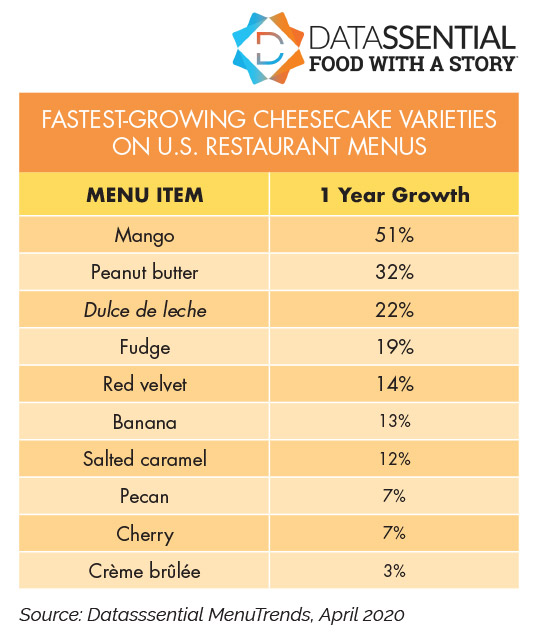
While more diners are looking for better-for-you options when it comes to other dayparts, when it comes time for dessert, they’re more open to a bit of indulgence. After all, dietary choices are all about maintaining balance.






